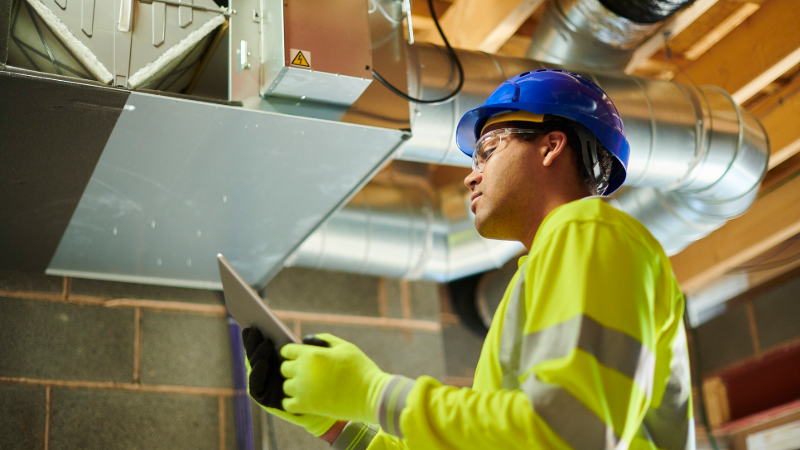How accurate, stable CO2 measurements cut HVAC costs and improve building air quality


Although CO2 is a well-known measurement parameter for HVAC control, how you measure it and the sensors you use can make a big difference to both energy efficiency and indoor air quality. Let’s look at some helpful tips on the most effective ways to optimize your HVAC systems with CO2 measurements.
The most common reason for measuring CO2 in HVAC applications, especially in demand-controlled ventilation systems, is to save energy. But the growing awareness of the impact of elevated CO2 levels on human health and employee productivity, together with tightening regulations on indoor air quality, is changing the game.
The importance of CO2 measurement in demand-controlled systems
The simplest way to control air quality is to monitor CO2 locally using a transmitter that indicates when levels are above the recommended limits, then react accordingly when limits are exceeded. The more sophisticated way is through demand-controlled ventilation, where the air flow rate is adjusted according to the CO2 level. In this case, CO2 is an indicator of air quality and is used as the input for demand-based controls in the air-handling unit.
This improves indoor air quality by maintaining the optimal level of ventilation while saving energy by avoiding over or under-ventilation. In this kind of setup, reliable CO2 measurement is critical, because without it the ventilation system will not function properly.
What to look for in a CO2 sensor
Control of your HVAC system can only be as precise as your measurements are. While low-quality sensors might be cheaper in the short term, they can cost you a great deal in the long run. They might break down faster, meaning you have to pay to repair or replace them regularly. Cheaper sensors can also suffer from drift, so they could be operating inaccurately without anyone knowing. This would mean the measurements they provide are no longer a valid input for the HVAC control system, making over or under-ventilation more likely.
The key is to look for the most accurate instruments available, with a fast response time, good long-term measurement stability, easy maintainability, and a long lifespan. While these kinds of sensors might cost more up front, you will save in the long run, with lower maintenance and energy costs. You’ll also be able to rest assured that the indoor air quality in the building is at the best possible level, keeping people healthy and productive.
Sensors represent a tiny part of the initial overall cost of an HVAC system, so investing a little extra in technologies that will make your system as efficient and effective as possible simply makes sense. Reliable, high-quality sensors that maintain their accuracy long-term are the ones that offer real lifetime value.
Watch out for claims about drift compensation
Some manufacturers will claim that the problem of drift isn’t something you need to worry about, with “fit-and-forget” solutions that use automatic background calibration software to compensate for drift.
But there’s a problem. The software typically assumes that the lowest readings are the same as the average outdoor CO2 concentration, and “calibrates” the sensor accordingly. This leads to tiny measurement errors compounding over time, becoming far more significant in the long term.
Systems like this are not suitable for spaces that have varying occupancy rates with peaks and troughs or spaces that are occupied 24/7. They are also easily fooled by building automation systems that aggressively ramp down fresh air intake during periods of low occupation. They also cannot account for any CO2 that is absorbed by concrete walls, leading to even greater inaccuracy and therefore even less precise ventilation control.
Remember that not all sensor technologies are the same
CO2 concentrations in air are measured using optical sensors, with measurement technologies based on how the CO2 in the air absorbs light. Conventional optical infrared sensors have a light source and a detector, which measures the amount of light only at the CO2 absorption wavelength. The signal at this wavelength attenuates at higher CO2 concentrations, and the intensity of this attenuation gives the CO2 concentration reading.
The problem with this type of technology is that any mechanical change in the sensor structure will cause drift and incorrect measurements. Additionally, the intensity of the light source diminishes over time, and any dirt or dust in the optical cuvette alters the reflectivity of the sensor and makes it seem to the detector as if the light source intensity has reduced. This reduction in light source intensity further contributes to measurement drift. To avoid this, many manufacturers add components to the sensor structure, such as an additional reference light source, or use software-based adjustments as mentioned above.
Vaisala CARBOCAP® technology for long-term accuracy
Vaisala’s CARBOCAP® technology avoids these problems with a single light source, filter, and detector that measure both reference and gas absorption in the same optical path. This true, continuous internal referencing eliminates drift and is the key to long-term measurement stability.
If you want to save on energy costs while maximizing indoor air quality, Vaisala CARBOCAP sensor technology is the best choice because it:
- offers excellent stability, with a recommended calibration interval of as long as five years
- is suitable for 24/7 occupied spaces and harsh environments because it can’t rely on assumptions about CO2 concentrations dropping
- has a long lifetime, with the micro-glow light source rated for 15 plus years of stable output
- works out of the box, with no need for an initial “learning period” in the installed environment
If you’d like to know more about how accurate, stable CO2 measurement can cut HVAC costs and improve building air quality, get in touch.



